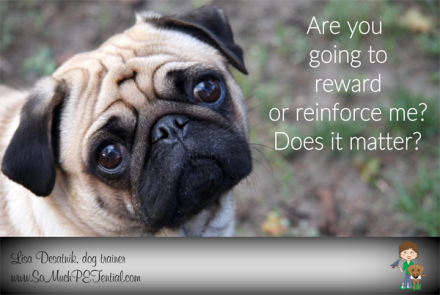When I was working with one of my puppy clients the other day, a question came up about rewarding behavior. Since I teach the most positive strategies for changing behavior, we talk a lot about reinforcement and consequences in my visits. It occurred to me that the topic of reward vs positive reinforcement was worth exploring again in my blog.
One thing I think about when I teach an animal like her (and her human) is how wonderful it is that she is showing me SO many possible reinforcers for teaching her behaviors.
Please click here to read my post about why knowing your pet’s Awesome List is important.
People often think of the words rewards and reinforcement being interchangeable but their interpretation can be different. So, I figured I’d write a post to give some clarity to it.
Let’s look first at reinforcement. Paul Chance’s definition (Learning & Behavior) is: the procedure of providing consequences for a behavior that increase or maintain the strength of that behavior.
That is very important to und erstand because behavior, simply put, is a tool for an animal to get a consequence. It is feedback that the animal uses as to whether or not that behavior should continue in the future.
erstand because behavior, simply put, is a tool for an animal to get a consequence. It is feedback that the animal uses as to whether or not that behavior should continue in the future.
In training, it is also important to note that the delivery of that reinforcer can greatly affect its effectiveness. Dr. Susan Friedman taught me that contingency occurs when the presentation of the reinforcer DEPENDS on the performance of the behavior. (If behavior X occurs, then consequence Y will occur.) An example of this is *if* Sam runs to his bed when given a verbal cue, *then* he gets a piece of chicken or *if* Sam walks by my side, *then* I will run with him to the grass to sniff.
The greater the contingency, the faster the learning curve, and that occurs with consistency in pairing the behavior and consequence. Contiguity is the amount of time between the behavior and the reinforcing consequence. The shorter the delay, the faster the learning process.
This is why moment markers (marking a specific behavior with a click, verbal word or something else specifically when the behavior occurs and following it with a reinforcer such as food) are so effective because they provide the learner with such precise feedback. The moment marker serves to tell the animal that YES, that is the behavior that is earning you reinforcement.
Reinforcers can be negative or positive. Negative reinforcement are consequences that are removed, avoided or escaped in the environment while positive reinforcement are stimulus added to the environment and are consequences the animal behaves to get. What they share is their impact on the future rate of the behavior, to either increase or maintain the behavior’s strength.
What we as trainers and teachers also need to understand is that reinforcement is absolutely the study of one and it can change from moment to moment. A hungry animal may have more value for food, and especially by food that it is not part of its everyday diet. A puppy in the morning may have more value for active play. Environmental reinforcers are all around too such as opportunities to sniff.
The proof of a reinforcer’s effectiveness is measured by the future rate of the behavior. That is key.
On the other hand, a reward by definition is something given in recognition of one’s service, effort, or achievement. However, what is important to note is that rewards are ONLY reinforcers when they increase or maintain the strength of behaviors.
A common mistake is when people *reward* behavior based upon what they ‘think’ the learner should value. As an example, I often see people reward their dog for coming by bending over to fluff up the fur on their dog’s head only to have their dog move backwards. There is a high probability that the recall behavior could break down instead of increase if the dog learns that something aversive will happen when he comes. By definition then, that reward is not a reinforcer but a punisher.
If people reward their dog for a behavior with a cheerio or verbal ‘good boy’ in a soft tone, and their dog’s fluency in that behavior weakens, then by definition that reward is also not a reinforcer.
The take-a-way here is to remember, if you want to teach and strengthen a behavior that you want your pet to do, make sure you are following that behavior with a consequence that is of value TO YOUR student.







